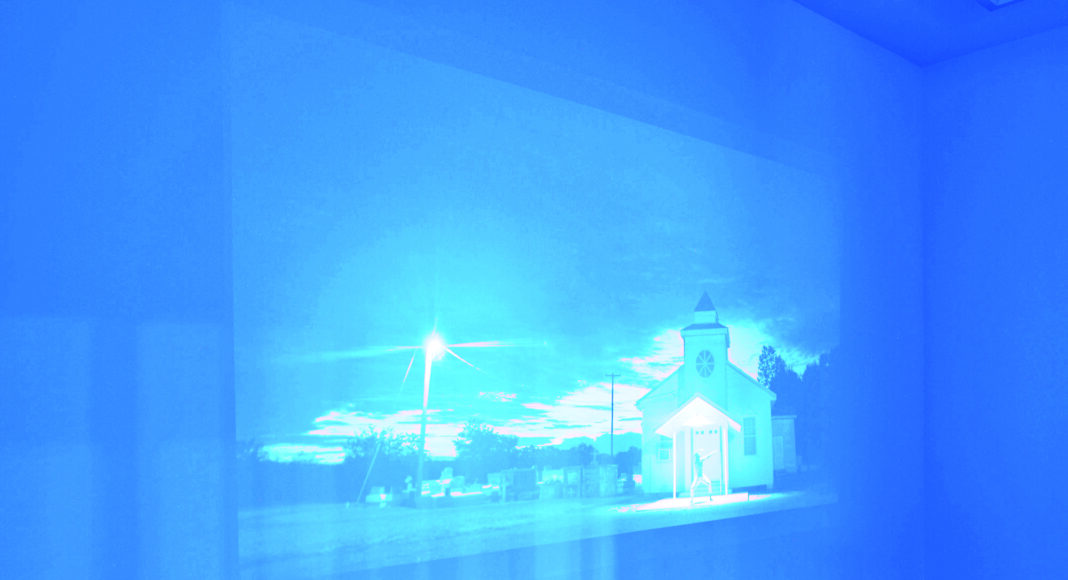Upon entering artist Adrian Burrell’s Sugarcane and Lightning pt. 3 in the David Pace Gallery at ICA, one feels not only transported to another space, but to a place outside of time.
From this new vantage point, time collapses and an entire history converges; many moments inhabit the same room. Here, the future waits quietly for its opportunity to strike.
Sugarcane and Lightning Pt. 3 begins with skylights muted by a lightning blue film and ropes made of sugarcane fabric, hanging like thick vines at the entrance.
Blue dominates the space, incorporated in neon signwork, light from the skylights and thick sheets of blue plastic which hang over the alcove where Burrell’s film is projected onto the wall.
Haunting yet galvanizing, the color evokes sadness, resistance and infinite possibility. The exhibit’s lighting and repeated color motif unite artworks created from many different mediums: a collage of family photos on corrugated shipping container steel, a film equal parts expressionist art and documentary, a wall of ceramic face casts glazed in varying hues of blue.
“I like finding the medium that best suits the story, like how the story wants to be told,” Burrell says.
The story is Burrell’s, but not solely his. Archival letters show the experience of a formerly enslaved ancestor of his, a centenarian and a widow, asking the government for reparations, or a pension on behalf of her deceased husband, while film footage shows Burrell dancing on plantation land where his ancestors were enslaved.
“They were enslaved by the Confederate Army during the Civil War in southwestern Louisiana. They both, until they died, had been searching for ways to get a pension and get reparations for what they had gone through. And that never came,” Burrell says.
In exploring his family history Burrell connects several threads, from their enslavement through to the gun violence he and his family have faced in Oakland. His art shows the evolution of white supremacist violence and the evolution of Black resistance in the face of oppression.
Curated by Zoë Latzer with text from visiting scholar and artist Luke Williams, the exhibition is Burrell’s story, and the story of many Black Americans.
“Unfortunately, my people have danced death for 500 years in this country, and we made it look good,” Burrell says.
His art explores the “repetition of catastrophe,” and how Black Americans have reacted to repeated waves of racist policy and thought with innovation.
“For instance, after slavery, we got reconstruction. And with reconstruction, we got the Ku Klux Klan. And with the Ku Klux Klan, we got the blues,” Burrell says. “So there’s this medium or way of being that acts as a way of refusal and escape for Black folks, that allows us to hold ourselves in and create ourselves anew.”
With this exhibition, Burrell says he’s singing the blues and cataloging his familial relationships in mixtape form. He pays tribute to the women in his life, his sisters, mother, and grandmother, who created community and spaces that were safe and joyful.
Growing up in Oakland, Burrell says people like his grandmother, Threater Lewis, held together a “social fabric” that protected the community. With the continued defunding and gentrification of Black communities in Oakland, that social fabric has eroded, opening the doors to gun violence and police violence in new ways.
Burrell has lost five family members to gun violence and faced police violence himself after he narrowly avoided a bullet. Rather than asking the Marine Corps veteran and Stanford lecturer if he was ok, Burrell felt the police were asking what he’d done to put himself in the crosshairs.
He says working in collaboration with his family members—some of whom are represented by ceramic casts of their faces emerging from the wall above letters they wrote to an as yet unseen future—is cathartic and healing.
“I’m doing what I can to not only combat erasure, but to create a living archive for my people to look back on 100 years from now, say[ing] we were here,” Burrell says. “This is how we lived, this is how we loved, you know? Just how we experienced joy.”
Sugarcane and Lightning: Part 3
Through Feb 23
ICA, San Jose



